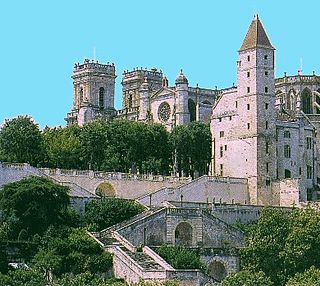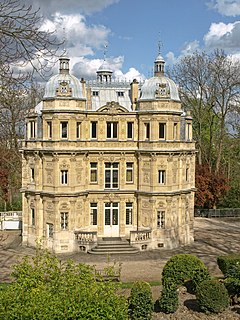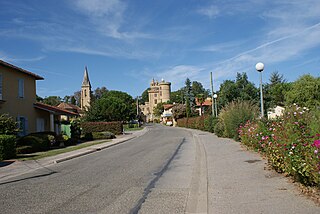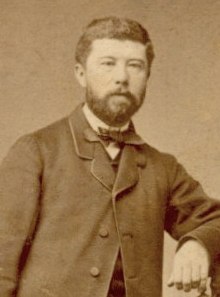
Biarritz is a city on the Bay of Biscay, on the Atlantic coast in the Pyrénées-Atlantiques department in the French Basque Country in southwestern France. It is located 35 kilometres (22 mi) from the border with Spain. It is a luxurious seaside tourist destination known for the Hôtel du Palais, its casinos in front of the sea and its surfing culture.

Auch is a commune in southwestern France. Located in the region of Occitanie, it is the capital of the Gers department. Auch is the historical capital of Gascony.

Paul Abadie was a French architect and building restorer. He is considered a central representative of French historicism. He was the son of architect Paul Abadie Sr..

Nice Cathedral is a Catholic cathedral located in the city of Nice in southern France.

The Château de Monte-Cristo is a writer's house museum located at Le Port-Marly in the Yvelines department of northern France. It was originally built as a residence for Alexandre Dumas, père.

Périgueux Cathedral is a Catholic church located in the city of Périgueux, France. A cathedral since 1669, it is dedicated to Saint Front. The cathedral's predecessor, still in operation as a church, is dedicated to Saint Stephen.

The Roman Catholic Archdiocese of Auch-Condom-Lectoure-Lombez, more commonly known as the Archdiocese of Auch, is an archdiocese of the Latin Rite of the Catholic Church in France. The archdiocese now comprises the department of Gers in south-west France. The archdiocese is a suffragan of the Archdiocese of Toulouse, and the current bishop, who therefore does not wear the pallium, is Maurice Marcel Gardès, appointed in 2004.

Saint-Blancard is a commune in the Gers department in the Occitanie region in southwestern France.

Adé is a commune in the Hautes-Pyrénées department in southwestern France.
Jean-Charles-Léon Danjoy was a French architect who specialized in renovating historical buildings.
Joseph-Auguste Lafollye (1828-1891) was a French architect. He is known for his restoration of the Château de Pau and other major public buildings.

Émile Boeswillwald was a French architect. He succeeded Prosper Mérimée as Inspector General of Historic Monuments and collaborated with Eugène Viollet-le-Duc.

Gabriel-Auguste Ancelet was a French architect who undertook various projects for the Emperor Napoleon III, and later taught for many years at the École des Beaux-Arts in Paris.
Louis Auguste Léodar Couvrechef (1827–1858) was a French architect who served Napoleon III as architect for the imperial residences.

Jean-Baptiste-Antoine Lassus was a French architect who became an expert in restoration or recreation of medieval architecture. He was a strong believer in the early Gothic architecture style, which he thought as a true French and Christian tradition, and was opposed to the classical Graeco-Roman styles promoted by the academic establishment.

Antoine Paul Selmersheim was a French diocesan architect. He is known for his design, construction, and restoration efforts on many churches during the 19th century. He became inspector-general of historical monuments.

St. Andrew's Church is a neo-Gothic Roman Catholic parish church in central Bayonne, Pyrénées-Atlantiques, France. It is dedicated to saint Andrew the Apostle.
Jacques Taurin de Lormand was a French politician and banker.















